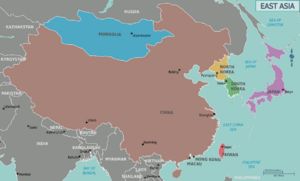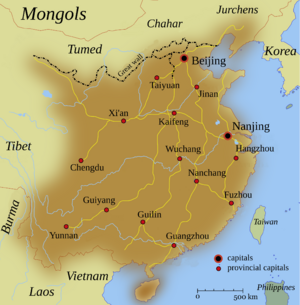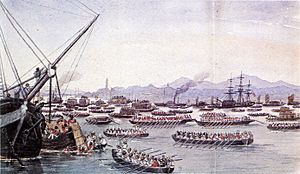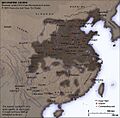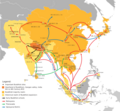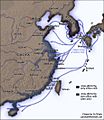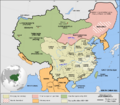History of East Asia facts for kids
East Asia includes the histories of China, Japan, Korea, Mongolia, and Taiwan. Each country has its own unique story. However, experts who study East Asia believe the region also shares a special way of developing over time. This can be seen in how these ancient civilizations connected with each other. Their relationships created layers of history that affected all or most of East Asia.
Contents
Understanding East Asian History
What is East Asian History?
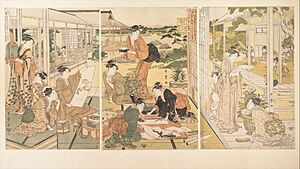
Studying East Asian history became popular in Western countries in the late 1800s. In the United States, people felt that many history classes focused too much on Europe. They wanted more courses about Asia. Today, East Asian History is a big part of Asian Studies.
Historians in East Asia often focus on how their own country's traditions and culture are special. This can help them claim land or solve problems within their country. Also, different writers have different ideas about society. This can lead to different versions of history. Because of this, some experts say we need to look at the bigger picture of the whole region.
Some scholars, like Andrew Abalahin, believe East Asia and Southeast Asia are one big cultural area. They share common roots and history. Historian Charles Holcombe says that East Asia is a unified cultural region because of its shared Confucianism, Buddhism, and the use of chopsticks.
A Quick Look at East Asia's Past
The countries in East Asia, like China, Japan, and Korea, were ruled by many different governments over time. Their borders often changed due to wars. Long, long ago, a type of early human called Homo erectus lived in East Asia. This was from about 1.8 million to 40,000 years ago.
Many important belief systems grew and spread across East Asia. These include Confucianism, Buddhism, and Taoism. China was ruled by early dynasties like the Xia, Shang, and Zhou. Later came the Qin and Han dynasties. In these early times, the regions had their own ways of politics, culture, and trade. They were not much affected by the outside world.
Written history in China began around 2000 BC with the Shang dynasty near the Yellow River. Civilization slowly spread to other parts of East Asia. In Korea, the first organized state, Gojoseon, appeared around 195 BC. Japan became a unified state with its first constitution in 604 AD. The arrival of Buddhism and the Silk Road were very important for East Asia's culture and economy.
Chinese dynasties like the Sui, Tang, and Song influenced early Japan and Korea. Around 1000 AD, China was the most advanced civilization in East Asia. It was responsible for the Four Great Inventions. Japan and Korea also became strong, centralized states.
The rise of the nomadic Mongol Empire changed East Asia. Leaders like Genghis Khan brought most of East Asia under one rule. The Yuan dynasty ruled most of modern China and all of Korea. The Yuan dynasty also tried to conquer Japan by sea but failed. The Mongol rule in East Asia was short. This was due to natural disasters and poor management.
After the Yuan dynasty fell, new governments like the Ming dynasty and Joseon dynasty adopted Neo-Confucianism. Japan, at this time, was in a long civil war called the Sengoku Jidai. This lasted for over 150 years. Around the 1500s, European traders and missionaries arrived in East Asia by sea for the first time. The Portuguese set up a colony in Macau, China. They also tried to spread Christianity in Japan. Towards the end of the Sengoku period, Japan tried to build a larger empire. It invaded Korea but was defeated by the combined forces of Korea and China.
From the 1600s, East Asian nations like China, Japan, and Korea chose to be isolated from Europe. The 1600s and 1700s saw great economic and cultural growth. Qing China was the strongest power in the region. However, Edo Japan remained completely independent. Limited contact with European traders led to the rise of Britain's East India Company. Japan also began to study Dutch knowledge.
In the 1800s, European countries started to build empires. Qing China could not defend itself from European attacks during the Opium Wars. Japan, on the other hand, chose to become more like the West. During the Meiji period, Japan modernized by following European and Western ideas. The growing Japanese Empire took over Korea in 1910. After years of civil war, China's last emperor, Puyi, gave up his throne in 1912. This ended China's long history of emperors.
In the early 1900s, Japan continued to expand. This led to the terrible Second Sino-Japanese War. Over twenty million people died during Japan's invasion of China. Japan's wars in Asia became part of World War II. After Japan attacked Pearl Harbor in the United States, America joined the war. Japan's defeat helped create a new world order. The world was now influenced by America and the Soviet Union. East Asia was caught in the middle of the Cold War. The People's Republic of China was allied with the Soviet Union. Japan, under American occupation, was tied to Western nations. Japan's economy grew very quickly after the war. This was called the post-war economic miracle. The competition between the Soviet Union and the West led to the Korean War. This war created two separate states that still exist today.
The end of the Cold War and the rise of globalization brought South Korea and the People's Republic of China into the world economy. Since 1980, their economies and living standards have grown a lot. Today, East Asia is a very important region. It has a big influence on world events. In 2010, about 24% of the world's population lived in East Asia.
Prehistoric Times
Homo erectus, meaning "upright man," is believed to have lived in East Asia from 1.8 million to 40,000 years ago.
In China, fossils of 40 Homo erectus individuals were found near Beijing. These are known as Peking Man. They date back about 400,000 years. This species likely lived in China for hundreds of thousands of years. They might have been the first to use fire and cook food. Homo sapiens (modern humans) moved into Asia. They probably followed herds of animals. They arrived in southern Siberia about 43,000 years ago. Some then moved south or east.
The earliest sites of farming culture in China include Nanzhuangtou (around 9500 BC), Pengtoushan (around 7500 BC), and Peiligang (around 7000 BC). China's first villages appeared at this time.
In Korea, the Jeulmun pottery period (20,000 BC to 8000 BC) is sometimes called the "Korean Neolithic." However, there is not much evidence of large-scale farming. People mostly hunted, gathered, and grew small amounts of plants.
The Jōmon period in Japan lasted from about 14,000 BC to 300 BC. It had features of both Stone Age and Middle Stone Age cultures.
Ancient East Asia (4,000 BC - 1,000 AD)
Early Chinese Dynasties
The Xia dynasty of China (from about 2100 to 1600 BC) is the first dynasty mentioned in ancient records. These records include Records of the Grand Historian and Bamboo Annals.
After the Xia came the Shang dynasty. They ruled in the Yellow River valley. The Shang ruled from about 1766 BC to 1122 BC.
The Zhou dynasty (about 1046–256 BC) lasted longer than any other Chinese dynasty. However, the Zhou rulers only had real control until 771 BC. This early period is called the Western Zhou. During this time, Chinese bronze-making reached its peak. The written language also developed into its modern form.
Nomadic People of Mongolia
In ancient times, the lands of modern Mongolia were home to nomadic tribes. Their cultures and languages often changed. People started using horses for herding and travel during the Iron Age. Many parts of Mongolia were influenced by Turkic peoples. The southwestern part was influenced by Indo-European peoples like the Tocharians.
In the east, Mongolic peoples lived. They were horse-riding herders who worshipped the sky god Tengri. They had close contact with the farming Chinese. These groups often bothered the Chinese state of Zhao. Chinese rulers sometimes gave important people as hostages and arranged marriages to keep peace.
In 208 BC, the Xiongnu emperor Modu Chanyu defeated the Donghu people. The Donghu split into new tribes, the Xianbei and Wuhuan. The Xiongnu were the biggest nomadic enemies of the Han dynasty. They fought wars for over 300 years before breaking up. After that, the Xianbei ruled the steppe north of the Great Wall. The titles of Khangan and Khan came from the Xianbei.
Ancient Korea
According to old Korean records, Gojoseon was founded in 2333 BC by Dangun. He was said to be the son of a heavenly prince and a bear-woman. Gojoseon developed its own culture. In 108 BC, the Chinese Han dynasty invaded and conquered Gojoseon. The Han set up four areas to rule the former Gojoseon land. After the Han Empire broke apart, the area was taken back by the Empire of Goguryeo in 313 AD.
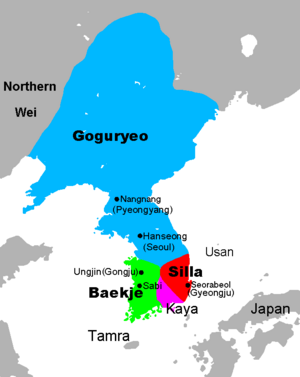
In 58 BC, the Korean Peninsula was divided into three kingdoms: Baekje, Silla, and Goguryeo. They shared a similar language and culture. But these three kingdoms constantly fought each other for control. Goguryeo also fought many wars with the Chinese. This included the Goguryeo–Sui War, where Goguryeo pushed back the invading forces of the Sui dynasty.
As Silla conquered nearby city-states, it reached the Yellow Sea. This allowed direct contact with the Tang dynasty of China. The Tang dynasty teamed up with Silla to invade Goguryeo. Goguryeo had stopped earlier Chinese invasions from the north. So, the plan was for Silla to attack from the south at the same time. To do this, the Tang-Silla alliance first defeated Baekje in 660. They captured its capital and royal family.
However, Yamato Japan and Baekje were close allies. In 663, Baekje and Japanese forces met Silla forces in the Battle of Baekgang. The Tang dynasty also sent soldiers and ships. After five naval battles, the Silla–Tang forces won.
The Silla–Tang forces then attacked Goguryeo. Goguryeo had defeated the Sui dynasty a century earlier. But attacks by the Tang dynasty from the west were too strong. The Silla–Tang alliance won the Goguryeo–Tang War. Silla then unified most of the Korean Peninsula in 668. Silla had to fight for almost ten years to push out Chinese forces. It finally created a unified kingdom that reached as far north as modern Pyongyang.
Early Japan
Japan was first lived in over 30,000 years ago. At that time, land bridges connected Japan to Korea and China. As sea levels rose, Japan's four main islands formed around 20,000 years ago. The land bridges disappeared about 15,000 to 10,000 years ago. After that, some people still migrated through the Korean peninsula. This became Japan's main way to exchange culture with mainland Asia. The old stories of Japan are in the Kojiki. This book tells the creation myth of Japan and how its Emperors came from the Sun Goddess Amaterasu.
Ancient pottery has been found in Japan. It shows two main periods: the Jōmon (about 7,500–250 BC) and the Yayoi (about 250 BC – 250 AD). "Jōmon" means 'cord marks'. It refers to the patterns on the pottery. This style was more decorative. The later Yayoi pottery was found in more places. It seems to have been made for more practical uses.
Confucianism and Taoism Begin
Confucianism and Taoism started during the Spring and Autumn period in China. They came from the ideas of Confucius and Laozi. These two belief systems sometimes competed but also worked together. Confucianism focuses on social order and respect for family. Taoism focuses on the universal force of the Tao and inner peace.
Confucianism is a system of ethics and philosophy. It became the official state idea of the Han dynasty. However, most Chinese emperors used a mix of Legalism and Confucianism to rule. When the Han dynasty fell, Buddhism and Taoism became more popular.
Confucianism saw a rebirth during the Tang dynasty. In the late Tang, it developed new ideas, becoming Neo-Confucianism. This new form was used for the imperial exams. It became the main philosophy for government officials in the Song dynasty. Confucianism was the most important idea in East Asia until the Qing dynasty fell in 1911.
Taoism comes from the mysterious figure of Laozi. He is said to have lived around 6th–5th century BC. His teachings were about personal calm, balance in the universe, and the life force of the Tao. The first organized form of Taoism began in the late 100s AD. It was called the Tianshi (Celestial Masters') school.
Taoism became officially recognized in China again during the Tang dynasty (618–907). The Tang emperors claimed Laozi as their ancestor.
Qin and Han Dynasties
In 221 BC, the state of Qin conquered the other six states. This created the first empire in China. After the first emperor, Qin Shi Huang, died, the Qin dynasty collapsed. The Han dynasty took control in 206 BC. In 220 AD, the Han empire broke into three kingdoms. The Silk Road, a series of trade routes, began during the Han dynasty.
Qin Shi Huang ruled China directly with total power. Unlike earlier dynasties, the Qin set up areas that reported directly to the emperor. The idea of Legalism was used to govern. Writings that promoted other ideas, like Confucianism, were banned. During his rule, China built the first continuous Great Wall. This was done using forced labor. Invasions were also launched south to take over Vietnam. Eventually, rebels rose against the Qin's harsh rule. They fought civil wars for control of China.
The Han dynasty then arose. It ruled China for over 400 years. This was a long period of wealth. The Han dynasty fought constant wars with the nomadic Xiongnu. The Han also played a big role in developing the Silk Road. This road moved goods and ideas across Asia for thousands of years. The Han also invented paper. Despite its success, the Han dynasty was weakened by powerful nobles. Public anger led to the Yellow Turban Rebellion. This rebellion, though it failed, sped up the empire's fall. After 208 AD, the Han dynasty broke into rival kingdoms. China remained divided until 581 under the Sui dynasty. During this time, Buddhism was first introduced to China.
China's Period of Division
The Three Kingdoms period included the kingdoms of Wei, Shu, and Wu. It began when the ruler of Wei, Cao Cao, was defeated. After Cao Cao died in 220 AD, his son became emperor of Wei. Other leaders declared themselves emperors of Shu and Wu. Many famous people in Chinese history lived during this time. Buddhism, which came during the Han dynasty, also became popular.
In 263 AD, Wei conquered Shu. Two years later, Wei's chancellor overthrew Wei and started the Western Jin dynasty. The Jin conquered Wu, uniting China again. However, the Western Jin did not last long. After the emperor died, a war weakened the Jin dynasty. It soon fell to another kingdom. This led to the Sixteen Kingdoms period.
The Northern Wei was founded in 386 AD. They united the northern part of China. During the Northern Wei, Buddhism grew strong. It became an important tool for the emperors. Soon, the Northern Wei split into the Eastern Wei and Western Wei. In the south, the dynasties were less stable.
Buddhism Spreads Across East Asia
Buddhism, a major religion in East Asia, came to China from Nepal in the 1st century BC. It then came to Korea from China in 372 AD. It finally reached Japan around the 500s AD.
For a long time, Buddhism was a foreign religion in China. During the Tang dynasty, Chinese priests translated many Buddhist texts. Buddhism then became one of China's main religions. In Korea, Buddhism mixed with nature worship. Mountains that were once home to spirits became sites for Buddhist temples. Buddhism was widely accepted in Korea. It was even supported by the government during many periods. However, Buddhism faced harsh treatment during the Joseon dynasty.
In Japan, Buddhism and Shinto were combined. People believed that Shinto gods were forms of Buddhist figures. This became the main idea of Japanese religion. Many Japanese people thought Buddhism and Shinto were one religion. This lasted until the government separated them in the mid-1800s.
In Mongolia, Buddhism became popular twice. First, during the Mongol Empire (1200s–1300s). Second, during the Qing dynasty (1600s–1800s). It mixed with Tengeriism and Shamanism.
Sui Dynasty
In 581 AD, Yang Jian overthrew the Northern Zhou. He established the Sui dynasty. Yang Jian, known as Sui Wendi, later conquered another dynasty. This united China. However, this dynasty was short-lived. Sui Wendi's successor, Sui Yangdi, expanded the Grand Canal. He also launched four terrible wars against Goguryeo. These projects used up the Sui's resources and workers. In 618 AD, Sui Yangdi was killed. Li Yuan then founded the Tang dynasty.
The Civil Service System
A government system supported by educated officials was perfected under Tang rule. These officials were chosen through civil service exams. This system was meant to find the best talents for government. It also helped Tang rulers avoid relying on powerful families or warlords. These officials gained status in their local areas. They also had family ties and shared values that connected them to the emperor. From Tang times until the end of the Qing dynasty in 1911–1912, these officials often linked local people to the government. This government model influenced Japan and Korea.
Medieval History (1000-1450)
Goryeo Kingdom in Korea
The Silla kingdom slowly declined. This led to new rebellious states forming. They took on the old names of Korea's ancient kingdoms. A peasant leader named Kyŏn Hwŏn took over the old Baekje land. He declared himself king of Later Baekje. Meanwhile, a Buddhist monk leader, Kung Ye, declared a new Goguryeo state in the north. This was known as Later Goguryeo. A long struggle for control of the peninsula followed.
Kung Ye began to call himself the Buddha. He started to punish people who disagreed with his religious ideas. He executed many monks, and even his own wife and two sons. People began to turn away from him. His expensive rituals and harsh rule caused more opposition. In 918, Kung Ye was removed by his own generals. Wang Kŏn, the chief minister, was made king. Wang Kŏn later became known as Taejo of Goryeo.
Soon after, the Goryeo dynasty was started. Taejo went on to defeat the rival Silla and Hubaekje. He reunited the three kingdoms in 936. After the Balhae kingdom was destroyed by the Khitan people in 927, its last prince and many nobles came to Goryeo. They were welcomed and given land by Taejo. Taejo included the Balhae prince in the Goryeo royal family. Korean historians say this brought a "true national unification" of Korea.
The Mongol Empire and Yuan Dynasty
In the early 1200s, Genghis Khan united the Mongol tribes. He created the Mongol Empire in 1206. The Mongols then conquered most of modern East Asia. China was divided into five competing states. From 1211, Mongol forces invaded North China. By 1234, the Mongols had defeated the Jin dynasty.
The northern part of China was taken by the Mongol Empire. In 1231, the Mongols began to invade Korea. They quickly captured most of the Goryeo territory. The Goryeo royal family moved to an island near Seoul. Korea was divided between those who worked with the invaders and those who resisted.
In the 1250s, the Mongols invaded the last state in southern China, the Southern Song. This invasion lasted over 30 years. It likely caused millions of deaths. In 1271, Kublai Khan declared the Yuan dynasty in China. The last parts of the Song were defeated in 1279. China was united under the Yuan dynasty. Kublai Khan moved his government to the Central Plains. He embraced Confucianism.
By 1275, Goryeo had surrendered to the Yuan dynasty. Members of the Goryeo royal family learned Mongol culture. They also married into the Yuan imperial family.
Japan was seriously threatened by the Yuan forces. In 1274, Kublai Khan sent an army to Japan. The Yuan dynasty invaded Japan twice. Both times, their invasions were stopped by natural typhoons. These typhoons swept their huge fleets into the sea. At the time, the Yuan dynasty fleet was the largest fleet in world history.
Japan's economy and military were under great stress. This was due to preparing for the powerful Yuan army. The Japanese government had trouble paying its soldiers. This caused problems among the warrior groups. The ruling system collapsed in the early 1300s.
Science and Technology
Gunpowder
Most sources say Chinese alchemists discovered gunpowder in the 800s. They were looking for a way to live forever. Gunpowder was likely found after hundreds of years of experiments. Saltpetre was known in China by the mid-1st century AD. There is strong evidence of saltpetre and sulfur being used in medicines. An old Chinese text from 492 noted that saltpetre made a purple flame when burned. This was the first way to tell it apart from other salts.
The first mention of gunpowder is probably in a Taoist text from the mid-800s. It says:

The oldest recipes for gunpowder are in the Chinese military book Wujing Zongyao from 1044 AD. It has three recipes. Two are for bombs to be thrown by siege machines. One is for poison smoke bombs. By the late 1100s, there were cast iron grenades filled with gunpowder. These could burst through their metal cases. A 1300s text describes gunpowder recipes that could create huge explosions.
In China, the 1200s saw the start of rocketry. The oldest gun still existing was also made then. It was like an early flamethrower that shot fire and shrapnel. The 1300s text also describes hollow, gunpowder-filled exploding cannonballs.
In the 1200s, gunpowder began to spread from China. The Mongols brought it to Europe and the Islamic world. Arabs learned about saltpetre, which they called "Chinese snow," around 1240. They soon learned about gunpowder, fireworks, and rockets. Persians called saltpetre "Chinese salt." Gunpowder reached India by the mid-1300s.
Printing
The first known movable type system was invented in China around 1040 AD. It was created by Pi Sheng. His type was made of baked clay. The world's first metal movable type was invented in Korea in 1234. This was 210 years before Johannes Gutenberg invented his printing press in Germany. Jikji is the oldest surviving book printed with movable metal type. It was published in 1377. This was 78 years before Gutenberg's famous Bible.
Early Modern History (1450-1750)
Ming Dynasty: 1368–1644
The Ming period was the only time in later Chinese history when all of China was ruled by ethnic Han people. Every county in China had a government and a Confucian school. The standard Chinese family system was used. Wealthy families, who owned land, were the most powerful local people. They paid close attention to their family history to show their high status.
In the early Ming period, families directly managed their large land holdings. But later, silver became more common as money. Land management then went to hired managers. The most talented young men went into government service. This meant that direct contact between the rich and the poor was less common.
In villages across China, wealthy families took part in the empire's life. They sent their sons to work in the imperial civil service. Most successful sons had a common education. They were chosen through competitive exams. They could be sent to work anywhere in the empire. At first, a recommendation from a local wealthy person was important. But the government started to rely more on merit exams. This made it harder to join the ruling class. Less successful sons could become peasants. But it was almost impossible for peasants to move up in society.
Qing Dynasty: 1644–1912
The Manchus, a tribe from Manchuria, conquered China between 1644 and 1683. This war killed about 25 million people. The Manchus ruled China as the Qing dynasty until the early 1900s. Han Chinese men were forced to wear a long pigtail as a sign of their lower status. However, some Han people did reach high ranks in government. Until the 1800s, Han Chinese were not allowed to move into Manchuria.
China had advanced art and science. But its science and technology stopped growing after 1700. In the late Qing era (1900 to 1911), China faced big civil wars and famines. It also lost wars to Britain and Japan. Powerful warlords controlled regions. Foreign countries interfered, like during the Boxer Rebellion of 1900. The empire finally collapsed in 1911.
Qing Military Success in the 1700s
The Qianlong Emperor led ten major military campaigns from the 1750s to the 1790s. These campaigns expanded Qing control into Inner Asia. At its peak, the Qing dynasty ruled over all of modern Mainland China, Taiwan, Mongolia, and parts of Russia.
Military Defeats in the 1800s
Despite its strong military past, the Qing state was very weak by the 1800s. Its army was poorly trained and lacked modern weapons. It also suffered from corruption.
China repeatedly lost to Western powers. In the two Opium Wars, China fought against Britain and France. China quickly lost both wars. After each defeat, the winners forced the Chinese government to give up a lot. After the first war (1839–1842), China gave Hong Kong island to Britain. Five "treaty ports" like Shanghai were opened for Western trade. After the second war, Britain gained more land. More cities were opened to trade.
The defeat in the Second Opium War (1856–1860) was very humiliating for China. British and French ambassadors went to Beijing to sign the treaty. The Chinese emperor expected them to show great respect, like bowing down. But Western powers saw China's government as old-fashioned. They refused to bow.
China tried to delay signing the treaty. Battles were fought, and Chinese forces were easily defeated. Eventually, Beijing was taken. The treaty was signed, and foreign embassies were set up. As revenge for Chinese killing of prisoners, British and French forces destroyed the Yuan Ming Yuan (Old Summer Palace). This huge complex of gardens and buildings outside Beijing burned for three days. A sign was put up saying, "This is the reward for treachery and cruelty." The palace was destroyed to punish the upper classes who ordered the crimes.
In 1884–1885, China and France fought a war. China accepted French control over its former states in what is now Vietnam. The Qing armies fought well in some areas. But the French sank much of China's modern navy in one afternoon.
China also lost repeatedly to Japan. Britain had helped Japan modernize its military. In 1879, Japan took over the Ryukyu Kingdom, which was a Chinese state. It became Okinawa. China could not send an army to help. In 1895, China lost the Sino-Japanese War. It gave Taiwan and other islands to Japan. It also had to give up control of Korea.
Rebellions in China
The Qing also had internal problems. There were several Muslim rebellions in the West. The Taiping Rebellion in the South killed millions of people.
The Taiping Rebellion (1851–1864) was led by a man who claimed to be Christ's younger brother. It was mostly a peasant revolt. The Taiping wanted land reform and to end slavery and other old customs. The Qing government, with some Western help, finally defeated the rebels. But the Taiping had ruled much of southern China for over ten years. This was one of the bloodiest wars ever fought.
Chinese people resented many things during this time. They disliked Christian missionaries, opium, and foreign countries taking Chinese land. They also disliked that foreigners were not subject to Chinese law. Westerners thought trade and missionaries were good. They believed their citizens needed protection from the Chinese system. But many Chinese saw these as more ways the West was taking advantage of China.
Boxer Rebellion 1898–1900
Around 1898, these feelings exploded. The Boxers, a peasant group, wanted to drive out foreign influences. Some believed their martial arts and prayers could stop bullets. They killed missionaries and Chinese Christians. They also surrounded the foreign embassies in Beijing. Eight nations—Germany, France, Italy, Russia, Great Britain, the United States, Austria-Hungary, and Japan—sent a force to rescue the embassies. The Qing had to accept foreign troops in Beijing. They also had to pay a large amount of money. Shanghai was also divided among China and the eight nations.
Last-Minute Reforms 1898–1908
The Hundred Days' Reform was a failed effort in 1898. It tried to change China's culture, politics, and education. The young Guangxu Emperor and his supporters led it. But powerful conservatives, led by Empress Dowager Cixi, stopped the reforms. She became the real ruler.
The Boxer Rebellion was a huge failure for China. The Qing rulers looked weak and lost respect. Foreign powers gained more influence. This humiliation led to a second reform movement. This time, Empress Dowager Cixi herself approved it. From 1901 to 1908, the dynasty announced many reforms. These included changes to education, the military, and government. In 1905, the exam system was abolished. This ended the Confucian tradition of joining the elite. This was a huge change. Scholars were no longer tied to old studies. Social mobility no longer depended on writing fancy essays.
New government offices were created. New laws were written. Work began on a national budget. The government did not know how much tax money was collected. New armies were raised and trained like European armies. Plans for a national army were made. The "new army" showed that military jobs were now respected. A new group of national leaders emerged. More officers and men could read and write. Patriotism and better pay encouraged people to join.
Reform and Revolution
The movement for a constitution grew after the Russo-Japanese War (1904–1905). Japan's victory showed that a constitutional government could win over an absolute ruler. Under pressure, the Qing court planned for local assemblies in 1909. A national assembly would follow in 1910. A constitution and parliament were planned for 1917. These assemblies made local leaders more involved in politics. They gave them new power to protect their interests.
Ironically, the reforms meant to save the Qing dynasty sped up its end. The reforms made people more aware of how far behind the Qing government was. Modern ideas emerged. Business people, students, women, soldiers, and Chinese living abroad demanded change. Government-sponsored education in Japan exposed Chinese youth to new ideas. Anti-Manchu groups formed in China by 1903. In Tokyo, groups joined to form the "Revolutionary Alliance" in 1905. It was led by Sun Yat-sen.
Joseon Korea: 1392–1897
In July 1392, General Yi Seong-gye overthrew the Goryeo dynasty. He founded a new dynasty, Joseon. As King Taejo of Joseon, he chose Hanyang (Seoul) as the new capital. During its 500-year rule, Joseon encouraged Confucian ideas in Korean society. Neo-Confucianism became the new government's main belief.
Joseon took strong control over the land of modern Korea. It saw a golden age of Korean culture, trade, literature, and science. The Joseon dynasty was a highly centralized monarchy. It had a government run by Confucian officials. The king had total power. But officials were expected to guide the king if he was wrong. He was bound by tradition and Confucian teachings.
In theory, there were three social classes. But in practice, there were four. The top class was the yangban, or "scholar-officials." Commoners were called sangmin. The lowest class was the cheonmin. Between the yangban and commoners was a fourth class, the chungin, or "middle people." Joseon Korea had a system controlled by civil and military officials called Yangban. Yangban tried to do well on royal exams to get high government jobs. They had to be good at calligraphy, poetry, and classical Chinese texts. To become an official, one had to pass a series of exams.
Edo Japan
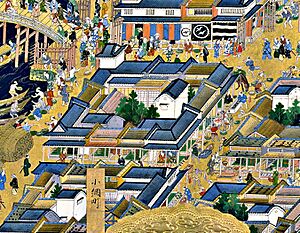
In 1603, the Tokugawa shogunate (a military government) began a long period of isolation from foreign influence. This helped them keep their power. For 250 years, this policy allowed Japan to have peace. Its unique culture also grew. Early modern Japanese society had a complex social structure. Everyone knew their place. At the top were the emperor and court nobles. They had great respect but little power. Next came the military rulers: the shōgun, daimyō, and feudal lords. They had the real power. The "daimyō" were about 250 local lords.
The upper classes enjoyed fancy and expensive rituals. These included elegant buildings, gardens, and the tea ceremony.
Three Cultures
Three different cultures existed during the Tokugawa era. They had little to do with each other. In the villages, peasants had their own traditions. In the high society of the imperial court and samurai, Chinese culture was very important. This was especially true for ethics and political ideas. Neo-Confucianism became the official philosophy. It was taught in schools. Confucian ideas about duty and family honor became deeply rooted in elite thinking. Chinese influence was also strong in painting, art, history, and science.
One exception was religion. There was a revival of Shinto, which came from Japan. Motoori Norinaga (1730–1801) helped separate Shinto from Buddhist ideas. He emphasized the myth of the emperor's divine origin. This later became a political tool for imperialist conquest.
The third cultural level was the popular art of common people. This included artisans, merchants, and entertainers. It centered around "ukiyo," the "floating world" of city entertainment areas. These places were officially off-limits to samurai. Actors were popular subjects for woodblock prints. They also appeared in novels and short stories. Theater, both puppet drama and kabuki, often showed the conflict between duty and desire.
Growth of Edo/Tokyo
Edo (Tokyo) was a small town for 400 years. But it grew quickly after 1603. This was when Shōgun Ieyasu built a fortified city there. It became the center of the new Tokugawa Shogunate. Edo was like European capital cities. It had military, political, and economic functions. The Tokugawa system had both feudal and government controls. So, Edo did not have one single administration. The typical city social order included samurai, workers, artisans, and business people. Artisans and business people were organized into official groups. Their numbers grew fast as Tokyo became a national trading center. Business people were not allowed in government. So, they created their own culture of entertainment. This made Edo a cultural center as well. When the Meiji Restoration happened, Tokyo's roles simply continued as the new capital of imperial Japan.
Western Colonialism (1750-1919)
The Meiji Era in Japan
After the Treaty of Kanagawa with the United States in 1854, Japan opened its ports. It began to quickly modernize and industrialize. The Meiji Restoration of 1868 ended the Tokugawa period. It put Japan on a path to a strong, modern government under the Emperor. In the late 1800s and early 1900s, Japan became a powerful regional force. It defeated the armies of both China and Russia. It took over Korea, Formosa (Taiwan), and southern Sakhalin Island.
Early 20th Century (1900-1950)
The Pacific War
In 1931, Japan took over Manchuria after the Manchurian Incident. In 1937, it launched a full-scale invasion of China. The U.S. gave a lot of military and economic help to China. It demanded that Japan leave China. Instead, Japan invaded French Indochina in 1940–41. In response, the U.S., Britain, and the Netherlands stopped oil imports to Japan in 1941. This cut off over 90% of Japan's oil. Talks with the U.S. failed. Japan attacked U.S. forces at Pearl Harbor in December 1941. This brought America into World War II. Japan quickly expanded its control by sea and land. It captured Singapore and the Philippines in early 1942. It also threatened India and Australia.
The war was long and bloody. Japan began to lose its advantage in 1942. At the Battle of the Coral Sea, a Japanese attack was stopped at sea for the first time. The Battle of Midway in June cost Japan four of its large aircraft carriers. This destroyed its ability to launch major attacks. In the Guadalcanal Campaign, the U.S. took back land from Japan.
U.S. Occupation of Japan
After its defeat in World War II, Japan was occupied by the U.S. until 1951. Japan recovered from the war. It became a strong economic power, a firm American ally, and a democracy. Emperor Hirohito was allowed to remain as a symbol of national unity. But real power was held by politicians, government officials, and business leaders.
The Cold War Era
Japan's economic growth after the war was called a "miracle." It was led by manufacturing. This started with textiles and clothing. It then moved to high-technology, like cars, electronics, and computers. The economy slowed down in the 1990s after 30 years of huge growth. But Japan is still a major global economic power.
The Chinese Civil War started again after World War II. In 1949, Mao Zedong declared the People's Republic of China. The Republic of China, which had ruled mainland China, moved to Taiwan. Since then, the Republic of China has only ruled Taiwan and nearby islands.
After Japan surrendered in World War II, Korea was divided at the 38th parallel. The Soviets controlled the northern half. The Americans controlled the southern half. In 1948, due to Cold War tensions, these zones became two separate countries. This led to the Republic of Korea (South Korea) and the Democratic People's Republic of Korea (North Korea). In 1950, North Korea invaded South Korea. It tried to unite the peninsula under communist rule. The United Nations, led by the United States, supported South Korea. China entered to protect North Korea. The Korean War (1950–1953) ended in a stalemate. The two Koreas are still separated by a military zone today.
Decline of Religion
Historically, cultures strongly influenced by Confucianism include China, Hong Kong, Macau, Taiwan, Japan, North Korea, and South Korea. This also includes areas with many Overseas Chinese, like Singapore. The end of the exam system in 1905 marked the end of official Confucianism. Intellectuals in the early 1900s blamed Confucianism for China's weaknesses. They looked for new ideas. These included the "Three Principles of the People" for the Republic of China. Later came Maoism under the People's Republic of China.
In Japan, a free society and consumerism led to a decrease in religious belief.
Around the early 2000s, there were talks of a "Confucian Revival" among scholars. Across the region, religious buildings and traditions have remained. But actual belief has declined.
Maps of East Asian History
|
|
See also
- East Asia–United States relations
- History of Asia
- History of China
- History of Hong Kong
- History of Japan
- History of Korea
- History of Mongolia
- History of Taiwan


